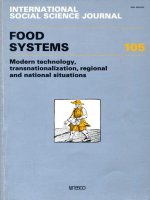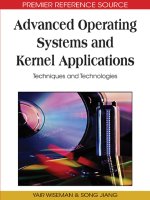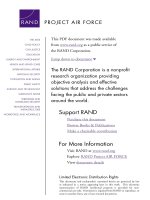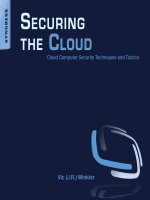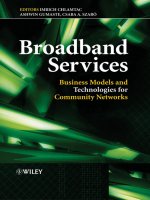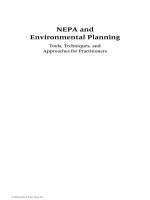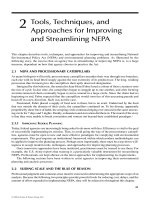modern software review techniques and technologies
Bạn đang xem bản rút gọn của tài liệu. Xem và tải ngay bản đầy đủ của tài liệu tại đây (4.37 MB, 342 trang )
i
Modern
Software Review:
Techniques and Technologies
Yuk Kuen Wong
Griffith University, Australia
IRM Press
Publisher of innovative scholarly and professional
information technology titles in the cyberage
Hershey • London • Melbourne • Singapore
ii
Acquisitions Editor: Michelle Potter
Development Editor: Kristin Roth
Senior Managing Editor: Amanda Appicello
Managing Editor: Jennifer Neidig
Copy Editor: Larissa Vinei
Typesetter: Marko Primorac
Cover Design: Lisa Tosheff
Printed at: Yurchak Printing Inc.
Published in the United States of America by
IRM Press (an imprint of Idea Group Inc.)
701 E. Chocolate Avenue, Suite 200
Hershey PA 17033-1240
Tel: 717-533-8845
Fax: 717-533-8661
E-mail:
Web site:
and in the United Kingdom by
IRM Press (an imprint of Idea Group Inc.)
3 Henrietta Street
Covent Garden
London WC2E 8LU
Tel: 44 20 7240 0856
Fax: 44 20 7379 0609
Web site:
Copyright © 2006 by Idea Group Inc. All rights reserved. No part of this book may be reproduced,
stored or distributed in any form or by any means, electronic or mechanical, including photocopying,
without written permission from the publisher.
Product or company names used in this book are for identification purposes only. Inclusion of the
names of the products or companies does not indicate a claim of ownership by IGI of the trademark
or registered trademark.
Library of Congress Cataloging-in-Publication Data
Wong, Yuk Kuen, 1973-
Modern software review : techniques and technologies / Yu Kuen Wong.
p. cm.
Summary: "This book provides an understanding of the critical factors affecting software review
performance and to provide practical guidelines for software reviews" Provided by publisher.
Includes bibliographical references and index.
ISBN 1-59904-013-1 (hardcover) ISBN 1-59904-014-X (softcover) ISBN 1-59904-015-8
(ebook)
1. Computer software Quality control. 2. Computer software Evaluation. 3. Computer software
Development. I. Title.
QA76.76.Q35W65 2006
005.1 dc22
2006003561
British Cataloguing in Publication Data
A Cataloguing in Publication record for this book is available from the British Library.
All work contributed to this book is new, previously-unpublished material. The views expressed in this
book are those of the authors, but not necessarily of the publisher.
iii
To my father and mother.
iv
Modern Software Review:
Techniques and Technologies
Table of Contents
Preface viii
Chapter I.
Why Software Review? 1
Abstract 1
Introduction 1
Why Study Software Review? 2
The Best Influences on Software Engineering 6
Aims and Significance of This Book 7
Summary 7
References 7
Chapter II.
Software Review History and Overview 12
Abstract 12
Introduction 13
Software Review 14
Terminology 15
Fagan’s Software Review 16
Forms of Review Process Structures 20
IEEE Standard for Software Reviews 23
Informal Approaches to Software Review 25
Summary 27
References 27
Chapter III.
Software Review Tools and Technologies 37
Abstract 37
Introduction 38
Paper-Based vs. Tool-Based Software Reviews 38
v
Collaborative Asynchronous vs. Synchronous Reviews 39
Applying Software Review Tools in the Software Review Process 40
Tools for Paper-Based Reviews 40
Web-Based Software Review Tools 40
Evaluation of Asynchronous and Synchronous Designs 42
Comparing Software Review Tools Features 44
Groupware Supported Inspection Process 45
Knowledge Centric Software Framework 47
Summary 48
Acknowledgment 49
References 49
Chapter IV.
How Software Review Tools Work 53
Abstract 53
Intelligent Code Inspection in a C Language Environment
(ICICLE) 54
Scrutiny 56
Collaborate Software Inspection (CSI) 57
InspeQ 59
CSRS 60
Requirement Traceability Tool (RADIX) 61
Asynchronous Inspector of Software Artefacts (AISA) 64
Web Inspection Prototype (WiP) 66
InspectA 68
HyperCode 69
Asynchronous/Synchronous Software Inspection Support Tool
(ASSIST) 71
Fine-Grained Software Inspection Tool/CodeSurfer 72
CORD 73
Agent-Based Software Tool 74
Internet-Based Inspection System (IBIS) 75
VisionQuest 77
Summary 78
References 78
Chapter V.
Software Review, Inputs, Process, and Performance 81
Abstract 81
Use of Inputs 82
Review Process 91
Software Review Performance 94
Limitations of the Current Software Review Literature 95
vi
Summary 98
References 99
Chapter VI.
A Theoretical Model for Analysis of Software Review
Performance 115
Abstract 115
Theoretical Model for Analysis Software Review Performance 116
Input-Process-Output 118
Inputs 118
Meeting Process Factors 126
Review Performance 128
Propositions and Hypotheses 129
Discussions of the Theoretical EIIO Model 136
Summary 140
References 140
Chapter VII.
Industry Software Reviews Survey Design 156
Abstract 156
Industry Survey of Software Reviews 156
Research Method 157
Survey Design 158
Questionnaire Design 159
Measurements 159
Sampling 169
Validation of Questionnaire 171
Data Collection 177
Analytical Methodology 179
Summary 186
References 186
Chapter VIII.
Industry Software Reviews Survey Results and Findings 196
Abstract 196
Industry Survey Findings 197
Response 197
Preliminary Data Analysis 205
Exploratory Analysis 207
Hypotheses Tests: Structural Equation Modelling (SEM) Using
Partial Least Squares (PLS) 210
Summary 228
References 229
vii
Chapter IX.
A Revised EIIO Model and a Simple Software Review Guide 234
Abstract 234
A Revised EIIO Model 235
A Simple Review Guide 249
Summary 250
References 250
Chapter X.
Case Study of Software Reviews 253
Abstract 253
Case Study Research 254
Case Study: In-Depth Interviews 254
Case Study: In-Depth Interview Procedures 255
Results 256
Discussions 264
Summary 266
References 266
Chapter XI.
Recommendations for Conducting Software Reviews 268
Abstract 268
Introduction 269
Recommendations for Conducting Software Reviews 269
Key Points for Researchers 277
Summary 278
References 278
Chapter XII.
Contributions and Future Directions of Software Review 281
Abstract 281
Contributions 281
Limitations 284
Future Directions 285
Summary 287
References 288
Appendix Section 291
About the Author 320
Index 321
viii
Preface
An Introduction to the Subject Area
High quality software is of vital importance for the survival and success of
companies where many manual tasks are now automated through software,
which can provide increased speed, accuracy, assurance, reliability, robustness,
and productivity. Software is often a key component of companies’ strategic
plans for gaining and sustaining competitive advantage. A single undetected
error or omission during the software development process could have disas-
trous consequences during operation. Software errors and omissions can also
lead to undesirable outcomes such as reduced customer satisfaction, increased
maintenance costs and/ or decreased productivity and profits.
Although information technology can be considered a well-established disci-
pline, software projects are still prone to failure. Even when a software project
is not classified as a failure, the general level of software quality leaves much
room for improvement. Software review or inspection is one of the important
techniques for improving software quality.
In the last thirty years, software reviews have been recommended as one of
the most cost effective quality assurance techniques in software process im-
provements and are widely used in industrial practice. The goal of software
review is to improve the quality of the product by reviewing interim deliverables
during design and development. It is defined as a “non-execution-based [tech-
nique] for scrutinizing software products for defects, deviations from develop-
ment standards”. Most researchers agree that software review is considered
the most cost effective technique in cost saving, quality and productivity im-
provements in software engineering. More specifically, software review can 1)
detect defects right through the software development life cycle from concept
ix
proposal to implementation to testing; the earlier defects are detected in devel-
opment, then the easier and less costly they are to remove/correct; and 2)
detect defects early in the software development life cycle that are difficult or
impossible to detect in later stages; improve learning and communication in the
software team, since software development is essentially a human activity.
Overall Objectives and
Mission of This Book
The overall objective and mission the proposed book is to provide:
• An understanding of the critical factors affecting software review
perfomance.
• Practical guidelines for software reviews.
Readers will gain a deep understanding of current software review literature
and theoretical models for analysis software review performance. More spe-
cifically, this helps readers to understand the critical input and process factors
that drive software review performance. Practical guidelines are drawn from
the literature, theoretical models, methodologies, and the results from industry
survey and cases studies.
The Scholarly Value of this Book and its Contributions to the Literature in the
Information Technology Discipline:
• To increase the understanding of what inputs the typical review process
uses in practice.
• To identify the key factors influencing software review
performanceTheoretical models help to understand the important relation-
ships between inputs, process, and performance perspective.
• The rigorous quantitative industry questionnaire survey and qualitative (case
study: in-depth interviews) case studies are contributed to the software
review literature.
• To provide useful and practical guidelines for organizing and conducting
software reviews.
x
Abstract
Information Technology can be considered a well-established discipline, how-
ever, software development projects are still prone to failure. Even if a soft-
ware project is not classified as a failure, the general level of software quality
leaves room for improvement. One of the most prevalent and costly mistakes
made in software projects today is deferring the activity of detecting and cor-
recting software problems until the end of the project (Boehm & Basili, 2001).
Hence, the cost of rework in the later stages of a project can be greater than
100 times that of the project costs (Fagan, 1976; Leffingwell & Widrig, 2000).
About 80% of avoidable rework comes from 20% of defects (Boehm & Basili,
2001). As a result, techniques such as software review for improving software
quality are important. The current software review literature lacks in empirical
evidence on identifying critical inputs and process factors influencing review
performance because there is little empirical manipulation of these variables.
Where inputs are manipulated, the results are often conflicting and inconsis-
tent. Hence, what inputs to use for effective software review in practice is still
open to determination. Different input requirements directly affect how the
software review is organized.
The overall objective of this book is to explore and understand the critical fac-
tors that significantly influence software review performance in practice. In
other words, the aim of this book is to further empirically validate the important
relationships between software review inputs, process, and performance. Thus,
this study is interesting and important for both researchers and practitioners.
The main structures of the book include: literature review, review software,
review tools, and technologies, understanding the relationships between inputs,
process and software review performance, development of a theoretical model,
development of the industry survey plan (instruments (questionnaire), design,
pre-tests, sampling, data gathering, data analysis), case study (in-depth inter-
views of the real life cases), recommendations, and the final writing.
In this book, both quantitative and qualitative methods were employed when
collecting and analysing empirical data in order to maximise the reliability and
validity of the study. A questionnaire mail survey was arranged with 205 re-
spondents from the software industry in Australia. A cross validation study
using an in-depth interview with experts was conducted with five cases (com-
panies). The rich qualitative data from the in-depth interviews and quantitative
data (statistical analysis) from the questionnaire survey offers a comprehen-
sive picture of the use of software review in practice. The final conclusion of
the book is drawn from a comparative analysis of the quantitative and qualita-
tive results. The empirical data obtained from surveys and in-depth interviews
with experts is cross-examined and discussed. The main conclusion of the study
is described below.
xi
The current empirical software review studies focus heavily on the explicit
inputs (e.g., supporting documents) rather than implicit inputs (reviewer char-
acteristics). However, the survey results in this study suggest that the implicit
inputs play a dominant role in software review performance. The findings sug-
gest that the characteristics of the software artefact have no significant direct
influence on software review performance and supporting documents have little
direct impact on review performance. The results show that only the use of
previously reviewed software documents has an effect on software review
performance. Interesting results demonstrate that reading techniques and pre-
scription documents have no impact on software review performance. It has
previously been argued in the software review literature that reading techniques
are considered the most effective explicit input for improving software review
performance, however, the survey results show that previously reviewed soft-
ware documents are more critical than reading techniques documents. Both
survey and in-depth interview results suggest that current reading techniques in
the software industry are not conclusively beneficial to software review per-
formance. This suggests that reading techniques documents need to be care-
fully designed and used in practice.
To achieve a higher performance in the software review process, selection of
reviewers becomes the most critical factor. These results confirm the theory
by Sauer, Jeffery, Land, and Yetton, (2000) and in part, Laitenberger and
DeBaud’s model (2000). In relation to reviewer motivation, interesting results
suggest that motivation, in particular, perceived contingency, is another impor-
tant factor in the software review process and review performance according
to the survey results. However, this variable is often ignored in the empirical
software review literature. Although several researchers have recommended
that reviewers’ motivation should be important in software review performance,
to our knowledge, no empirical study has been carried out to support this. The
findings suggest that company support, encouragement and reviewer agree-
ment for the way the company conducts software review helps to increase
reviewers’ motivation and effort and hence improve review performance.
Finally, teamwork is the dominant factor in the review meeting process. The
survey results show that teamwork is the best indicator of a successful soft-
ware review meeting. The more collaborative a review team, the higher the
software review performance that can be achieved.
In summary, the key driver to software review performance is reviewers’ ex-
perience, followed by previously reviewed software documents, perceived con-
tingency (support, encouragement, and reviewer agreement with the company),
and teamwork.
xii
Structure of This Book
This book is organised into twelve chapters. Each chapter is briefly summarised
as follows:
Chapter I discusses why study software review. The chapter identifies advan-
tages of software review that include improving software quality, cost saving,
and productivity. In particular, the chapter presents experts’ opinions — the
impact of software review on software engineering. In the final section of the
chapter, the book addresses the aim of the book and the organization of the
book.
Chapter II presents the software review literature including the history of
software review, forms of software review structure, and informal review ap-
proaches. More specifically, in the literature review, the chapter reviews the
six-step Fagan’s Software Review (i.e., planning, overview, preparation, group
meeting, reworks, and follow-up), form software review structure (i.e., Active
Design Review, Two-Person Review, N-fold Review, Phased Review, Use of
Review Meeting), IEEE standard for software review, informal review ap-
proaches (i.e., Walkthrough, Pair Programming, Peer Check, Pass-Around),
and a comparison of formal and informal review approaches.
Chapter III describes tools and technologies for software review. The chap-
ter starts with an explanation of the difference between paper-based and tool-
based software reviews, as well as collaborative asynchronous vs. synchro-
nous software review. Followed by an evaluation and comparison of software
review tools’ features. The chapter identifies the tools features for the group
review process. The final section of the chapter reviews a framework for sup-
porting tool-based software processes.
Chapter IV discusses software review tools and how they support the soft-
ware review process. Tools including: Intelligent Code Inspection in “C” Lan-
guage (CICLE), Scrutiny, Collaborate Software Inspection (CSI), InspeQ, CSRS,
Requirement Traceability (RADIX), InspectA, Asynchronous Inspector of Soft-
ware Artefacts (AISA), Web Inspection Prototype (WiP), HyperCode, Asyn-
chronous/Synchronous Software Inspection Support Tool (AISSIT), Fine-Grained
Software Inspection Tool, CORD, Agent-based Software Tool, Internet-based
Inspection System (IBIS), and VisionQuest are discussed in the chapter.
Chapter V presents use of software review inputs, supporting process struc-
ture techniques, methods of measuring software review performance, and the
limitations of the current software review literature. In particularly, the chapter
reviews use of inputs (that include review task, supporting documents, reviewer
characteristics), review process (team size, roles design, decision-making method
xiii
during the review process, and process gain and losses), and qualitative and
quantitative methods for performance measurement. The chapter also identi-
fies limitations of the current software review literature.
Chapter VI proposes a theoretical model for analysing software review per-
formance. The Explicit and Implicit Input-process-Output (EIIO) Model is de-
veloped for further analysis software review performance. The model includes
three major components–inputs, process, and output. Inputs can be classified
into explicit inputs and implicit inputs. Explicit inputs refer to software review
task (artefact) characteristics and supporting documents. Supporting documents
include reading techniques (e.g., checklist, scenarios readings), business re-
ports, prescription documents, and previously reviewed software documents.
Implicit inputs include reviewers’ ability and their motivations. During the meeting
process, the process factors can be classified into communication, teamwork,
status effect, and discussion quality. Software review performance is often
measured by the number of defects found. The chapter presents the important
relationships between inputs, process, and performance. Five propositions be-
tween these relationships are discussed in the final section of the chapter.
Chapter VII presents the Industry survey design. In order to understand how
practitioners conduct their software reviews in their development environment
in software industry, an industry survey is conducted. The industry survey can
also validate the theoretical EIIO model. The chapter mainly discusses the in-
dustry survey design. A survey plan (i.e., research method, survey design, ques-
tionnaire design, measurements of models and scales, sampling techniques, vali-
dation of questionnaire procedures, data collection methods, data analysis meth-
ods) is detailed described in the chapter.
Chapter VIII discusses industry survey results and findings. The overall sur-
vey results provide an understanding of software review in practice and a vali-
dation of the proposed EIIO model. This allows better understanding of the
direct and indirect relationships between software review inputs, process, and
performance. The survey includes four major procedures–response, prelimi-
nary analysis, exploratory analysis, and hypotheses tests. The response section
discusses response rate, response characteristics, and response bias. The pri-
mary analysis focuses on descriptive and missing value analysis whereas, ex-
ploratory analysis focuses on reliability and validity of the survey results. The
hypotheses tests analysis effects on software review inputs, process, and per-
formance.
Chapter IX discusses the revised EIIO model. This presents interesting re-
sults from a comprehensive data analysis procedure. The chapter provides a
simple review guide (four steps of conducting software review) after discus-
sions of the revised EIIO model.
Chapter X presents an industry cases study. The case study provides qualita-
tive results and rich information from industry experts’ opinions. The method
xiv
used in the case study is in-depth interview. The data collection procedures and
the findings are discussed in the chapter. The findings include 1) issues of con-
ducting software review, 2) common types of software review inputs, 3) dis-
cussions of inputs affect review process and performance, and 4) discussions
of process affect performance (review outcome).
Chapter XI presents practical guidelines and recommendations for both prac-
titioners and researchers. Useful recommendations of use of inputs, the need
for team review meetings and selection measurement metrics (review perfor-
mance) are provided in the chapter.
Chapter XII concludes contributions and future directions. Theoretical and
methodological contributions are addressed. The chapter discusses limitations
of the industry studies in this book and future software review directions.
References
Boehm, B. W. & Basili, B. R. (2001). Software defect reduction top 10 list.
IEEE Computer, 34(1), January.
Fagan, M. E. (1976). Design and code inspections to reduce errors in program
development. IBM System Journal, 15(3), 182-211.
Laitenberger, O. & Debaud, J. M. (2000). An encompassing life cycle centric
survey of software inspection. The Journal of Software and Systems,
50(1), 5-31.
Leffingwell, D. & Widrig, D. (2000). Managing software requirements: A
unified approach. NJ: Addison Wesley.
Sauer, C., Jeffery, R., Land, L., & Yetton, P. (2000). Understanding and im-
proving the effectiveness of software development technical reviews: A
behaviourally motivated programme of research. IEEE Transactions on
Software Engineering, 26(1), 1-14.
xv
Acknowledgment
In preparing this book, I received tremendous help from a number of individuals
whom I would like to thank. I would like to thank many people for their help and
support while I was carrying out my book.
Special thanks go to Professor Waynne Chin from The University of Houston
for providing Structural Equation Modeling Partial Least Square (SEM-PLS)
workshops and advising on the execution of statistical data analysis and meth-
odology design.
I am extremely grateful for the work of a great team at Idea Group Inc. In
particular, to Kristin Roth who continuously addressed all my questions and
prodded for keeping the project on schedule and to Mehdi Khosrow-Pour and
Jan Travers for the invitation. Thanks to various reviewers for their critical
comments and feedback on this book. I would like to thank the volunteers par-
ticipating in the industry survey and the case study. Thanks to the voluntary
students that provided additional help.
Finally, I would like to thank a number of friends and colleagues, who in their
own separate ways, kept me sane during this undertaking. And of course, thanks
goes to my family for all their support.
Yuk Kuen Wong, PhD
xvi
Why Software Review? 1
Copyright © 2006, Idea Group Inc. Copying or distributing in print or electronic forms without written
permission of Idea Group Inc. is prohibited.
Chapter I
Why Software Review?
Abstract
The aim of this chapter is to discuss the benefits of software review. The key
benefits of software are improving software quality and providing cost
saving and productivity improvement. It has been agreed that software
review is one of the best influence on software engineering. This chapter
describes the structure of the book and explains each chapter’s focus. The
overall objective of this book is to provide an understanding of the critical
factors affecting software review performance and to provide practical
guidelines for software reviews.
Introduction
High quality software is of vital importance for the survival and success of
companies where many manual tasks are now automated through software,
which can provide increased speed, accuracy, assurance, reliability, robustness,
and productivity (Chen & Wei, 2002; Humphrey, 1995, 2002b; Will & Whobrey,
2 Wong
Copyright © 2006, Idea Group Inc. Copying or distributing in print or electronic forms without written
permission of Idea Group Inc. is prohibited.
1992, 2003, 2004). Software is often a key component of companies’ strategic
plans for gaining and sustaining competitive advantage (Gilb & Graham, 1993;
Humphrey, 2002a, 2002b). A single undetected error or omission (Will &
Whobrey, 2004) during the software development process could have disastrous
consequences during operation (Humphrey, 1995; Parnas & Lawford, 2003a,
2003b). Software errors and omissions can also lead to undesirable outcomes,
such as reduced customer satisfaction, increased maintenance costs, and/or
decreased productivity and profits (Schulmeyer & Mcmanus, 1999).
Although information technology can be considered a well-established discipline,
software projects are still prone to failure (Humphrey, 2002b; Sommerville, 2001,
1995; Voas, 2003). Even when a software project is not classified as a failure,
the general level of software quality leaves much room for improvement (Boehm
& Basili, 2001; Chen, Kerre, & Vandenbulcke, 1995; Lyytinen & Hirschheim,
1987). Software review or inspection is one of the important techniques for
improving software quality (Boehm & Basili, 2001; Fagan, 1986; Thelin, Runeson,
& Wohlin, 2003).
The goal of software review is to improve the quality of the product by reviewing
interim deliverables during design and development (Fagan, 1976, 1986; Porter
& Votta, 1997, 1998). Defects are detected early and removed before the
product is released (Sommerville, 2001; Xu, 2003; Zhu, Jin, Diaper, & Ganghong,
2002).
Software review or inspection is a widely recommended technique for improving
software quality and increasing software developers’ productivity (Fagan, 1976;
Freedman & Weinberg, 1990; Gilb & Graham, 1993; Humphrey, 1995; Strauss
& Ebenau, 1994). In particular, Fagan’s review (or inspection) is recommended
as one of the ten best influences on software development and engineering
(Boehm & Basili, 2001; Biffl, 2001; Biffl & Halling, 2003; Briand, Freimut, &
Vollei, 1999; Fagan, 1986; Gilb & Graham, 1993; McConnell, 1993; Wohlin,
Aurum, Petersson, Shull, & Ciolkowski, 2002). Software review was originally
proposed by Michael Fagan at IBM in early 1970’s (Fagan, 1976).
Why Study Software Review?
Software review is an industry-proven process for eliminating defects. It has
been defined as a “non-execution-based [technique] for scrutinizing software
products for defects, and deviations from development standards” (Ciolkowski,
Laitenberger, & Biffl, 2003). Most researchers agree that software review is
considered the most cost effective technique in cost saving, quality, and
productivity improvements in software engineering (Ackerman, Buchwald, &
Why Software Review? 3
Copyright © 2006, Idea Group Inc. Copying or distributing in print or electronic forms without written
permission of Idea Group Inc. is prohibited.
Lewski, 1989; Basili, Laitenberger, Shull, & Rus, 2000; Biffl, 2001; Boehm &
Basili, 2001; Fagan, 1986; Gilb & Graham, 1993; Russell, 1991). Studies show
that 42% of defects result from a lack of traceability from the requirements or
design to the code (O’Neill, 1997a, 1997b). More specifically, software review
can (Briand, Freimut, & Vollei, 2000):
• Detect defects right through the software development life cycle from
concept proposal to implementation to testing; the earlier defects are
detected in development, then the easier and less costly they are to remove/
correct,
• Detect defects early in the software development life cycle that are
difficult or impossible to detect in later stages, and;
• Improve learning and communication in the software team (Huang, 2003;
Huang et al., 2001), since software development is essentially a human
activity.
Improve Software Quality
A defect is an instance in which a requirement is not satisfied.
(Fagan, 1986)
One of the benefits of software review is to improve software quality in the early
stages of the software development cycle (Basili & Selby, 1987; Basili et al.,
2000; Biffl, 2001; Boehm & Basili, 2001; Calvin, 1983; Christenson, Steel, &
Lamperez, 1990; Fagan, 1976, 1986; Freedman & Weinberg, 1990; Humphrey,
2000, 2002a, 2002b; Shull, Lanubile, & Biasili, 2000; Travassos, Shull, Fredericks,
& Basili, 1999).
Experience reports also show that software review consistently improves
software quality (Ackerman et al., 1989; Collofello & Woodfield, 1989; Fagan,
1976; Kitchenham, Kitchenham, & Fellows, 1986; Knight & Myers, 1993;
Weller, 1993). Past studies have shown that software review is an effective
technique that can catch between 31% and 93% of the defects, with a median
of around 60% (Ackerman et al., 1989; Barnard & Price, 1994; Basili & Selby,
1987; Boehm & Basili, 2001; Collofello & Woodfield, 1989; Fagan, 1976, 1986;
Kitchenham et al., 1986; Knight & Myers, 1993; Weller, 1993).
For example, Fagan (1976) reported that 38 defects had been detected in an
application program of eight modules (4439 non-commentary source statements
written in Cobol, by two programmers at Aetna Life and Casualty), yielding
4 Wong
Copyright © 2006, Idea Group Inc. Copying or distributing in print or electronic forms without written
permission of Idea Group Inc. is prohibited.
defect detection effectiveness for reviews of 82%. Kitchenham et al. (1986)
found that 57.7% of defects were found by software reviews at ICL where the
total proportion of development effort devoted to software reviews was only 6%.
Conradi, Marjara, and Skatevik (1999) found at Ericsson in Oslo that around 70%
of recorded defects, took 6% to 9% of the development effort, and yield an
estimated saving of 21% to 34%.
In addition, Grady and Van-Slack (1994) reported defect detection effectiveness
for code reviews varying from 30% to 75% whereas Barnard and Price (1994)
reported an average of 60% to 70% of the defects were found via code review
at Hewlett Packard. In a more recent study, it has been suggested that software
reviews removed 35% to 90% of all defects during the development cycle
(Boehm & Basili, 2001).
Cost Saving and Productivity Improvement
Another benefit of software review is to reduce development costs and improve
productivity. One of the most prevalent and costly mistakes made in software
projects today is deferring the activity of detecting and correcting software
problems until the end of the project (Boehm & Basili, 2001). The cost of rework
in the later stages of a project can be greater than 100 times the cost of correction
in the early stages (Fagan, 1976; Leffingwell & Widrig, 2000). About 80% of
avoidable rework seems to come from 20% of defects (Boehm & Basili, 2001).
A traditional defect detection activity, such as formal testing, only occurs in the
later stages of the software development cycle when it is more costly to remove
defects. Testing typically leads to quick fixes and ad-hoc corrections for
removing defects; however, those measures reduce maintainability.
Most studies have claimed that the costs for identifying and removing defects in
the earlier stages are much lower than in later phases of software development
(Ackerman et al., 1989; Basili et al., 2000; Ciolkowski et al., 2003; Fagan, 1986;
Weller, 1993). For instance, the Jet Propulsion Laboratory (JPL) found the ratio
of the cost of fixing defects during software review to fixing them during testing
between 1:10 and 1:34 (Kelly, Sherif, & Hops, 1992), the ratio was 1:20 at the
IBM Santa Teresa Lab (Remus, 1984), and at the IBM Rochester Lab it was
1:13 (Kan, 1995). As a result, techniques such as software review for early
defect detection are highly necessary.
Software review is a human-based activity to “verify” that software can meet
its requirements (Fagan, 1986); where software review costs are directly
determined by reviewers’ efforts. Davis (1993) measured the cost of errors from
various stages of the system development life cycle and reported that huge cost
Why Software Review? 5
Copyright © 2006, Idea Group Inc. Copying or distributing in print or electronic forms without written
permission of Idea Group Inc. is prohibited.
savings could be achieved from finding defects in early stages. Finding defects
in the early stage of requirements versus finding errors during the final stage
of maintenance leads to a ratio of cost savings of 200:1 (Davis, 1993) (see
Figure 1).
Despite perceptions that software reviews are additional work that slow the
development, there is ample evidence that software reviews actually reduce
development time, as reviews are more efficient than other methods such as
testing (Ackerman et al., 1989; Bourgeois, 1996; Collofello & Woodfield, 1989;
Kitchenham et al., 1986; Weller, 1993). Software projects are often required to
deliver high quality software in limited timeframes to tight deadlines.
Numerous experience reports have proved that software review techniques can
significantly reduce costs and improve software development productivity
(Ackerman et al., 1989; Bourgeois, 1996; Fagan, 1976, 1986; Gilb & Graham,
1993; Kitchenham et al., 1986; Musa & Ackerman, 1989; Weller, 1993; Wheeler,
Brykczynski, & Meeson, 1996). For instance, Ackerman et al. (1989) reported
that they took 4.5 hours to eliminate a defect by unit testing compared to 2.2 hours
by software code review while Weller (1993) found that testing took about six
hours to find each defect while software review took less then one hour per
defect.
Further, Jet Propulsion Laboratory (JPL) took up to 17 hours to fix defects during
formal testing, in a documented project. The average effort for 171 software
Figure 1. Relative cost to repair a defect at different lifecycle phases (Diagram
0.1-0.2
1
0.5
2
5
20
Stage
Requirement
Design
Coding
Unit Test
Acceptance Test
Maintenance
Relative Costs to Repair
Figure 1. Relative cost to repair a defect at different lifecycle phases
(Adopted from Leffingwell & Widrig, 2000)
6 Wong
Copyright © 2006, Idea Group Inc. Copying or distributing in print or electronic forms without written
permission of Idea Group Inc. is prohibited.
reviews (five members) was 1.1 staff-hours per defect found and 1.4–1.8 staff
hours per defect found and fixed (Bourgeois, 1996). Kitchenham et al. (1986)
reported that the cost of detecting a defect in design inspections was 1.58 hours
at ICL.
In summary, software review is the most cost effective technique for improving
software quality by detecting and removing software defects during the early
stages of the software development life cycle (Basili et al., 1996; Fagan, 1986;
Gilb & Graham, 1993).
The Best Influences on
Software Engineering
“One of the great breakthroughs in software engineering was Gerald Weinberg’s
concept of egoless programming–the idea that no matter how smart a program-
mer is, reviews will be beneficial. Michael Fagan formalized Weinberg’s ideas
into a well-defined review technique called Fagan inspections. The data in
support of the quality, cost and schedule impact of inspections is overwhelming.
They are an indispensable part of engineering high-quality software. I propose
Fagan inspection (review) as one of the 10 best influences.” (McConnell, 2000)
“Inspections (reviews) are surely a key topic, and with the right instrumentation
and training they are one of the most powerful techniques for defect detection.
They are both effective and efficient, especially for upfront activities. In addition
to large scale applications, we are applying them to smaller applications and
incremental development” (Chris Ebert, in McConnell, 2000).
“I think inspections (reviews) merit inclusion in this list. They work, they help
foster broader understanding and learning, and for the most part they do lead to
better code. They can also be abused–for instance, in cases where people
become indifferent to the skill set of the review team, or when they don’t bother
with testing because they are so sure of their inspection process” (Terry
Bollinger, in in McConnell, 2000).
“I would go more basic then this. Reviews of all types are a major positive
influence. Yes, Fagan inspection (review) is one of the most useful members of
this class, but I would put the class of inspections and reviews in the list rather
than a specific example” (Robert Cochran, in McConnell, 2000).
After this overview of the benefits of software review, the aims and significance
of this study are described in the next section.
Why Software Review? 7
Copyright © 2006, Idea Group Inc. Copying or distributing in print or electronic forms without written
permission of Idea Group Inc. is prohibited.
Aims and Significance of This Book
The overall objective and mission the proposed book is to provide:
• An understanding of the critical factors affecting software review perfor-
mance, and;
• Practical guidelines for software reviews.
Readers will gain a deep understanding of current software review literature and
theoretical models for analysis software review performance. More specifically,
this helps readers to understand the critical input and process factors that drive
software review performance. Practical guidelines are drawn from the litera-
ture, theoretical models, methodologies, and the results from industry surveys
and cases studies.
Summary
This chapter outlines the benefits of software review and importance in software
engineering discipline. History of software review, terminology used, and an
overview of current literature will be discussed in next chapter.
References
Ackerman, F. A., Buchwald, L. S., & Lewski, F. H. (1989, May). Software
inspection: An effective verification process. IEEE Software, 31-36.
Barnard, J., & Price A. (1994, March). Managing code inspection information.
IEEE Software, 59-69.
Basili, V. R., & Selby, R. W. (1987). Comparing the effectiveness of software
testing strategy. IEEE Transaction on Software Engineering, 13(12),
1278-1296.
Basili, V. R., Green, S., Laitenberger, O., Lanubile, F., Sorumgard, S., &
Zelkowitz, M. (1996). The empirical investigation of perspective-based
reading. International Journal on Empirical Software Engineering,
1(12), 133-144.
8 Wong
Copyright © 2006, Idea Group Inc. Copying or distributing in print or electronic forms without written
permission of Idea Group Inc. is prohibited.
Basili, V. R., Laitenberger, O., Shull, F., & Rus, I. (2000). Improving software
inspections by using reading techniques. Proceedings of International
Conference on Software Engineering (pp. 727-836).
Biffl, S. (2001). Software inspection techniques to support project and
quality management: Lessons learned from a large-scale controlled
experiment with two inspection cycles on the effect defect detection
and defect estimation techniques. Unpublished PhD Thesis. Department
of Software Engineering, Vienna University of Technology, Australia.
Biffl, S., & Halling, M. (2003, May). Investigating the defect detection effective-
ness and cost benefit of nominal inspection team. IEEE Transaction on
Software Engineering, 29(5), 385-397.
Boehm, B. W., & Basili, B. R. (2001, January). Software defect reduction top
10 list. IEEE Computer, 34(1).
Bourgeois, K. V. (1996). Process insights from a large-scale software inspec-
tions data analysis, cross talk. Journal Defence Software Engineering,
17-23.
Briand, L. C., Freimut, B., & Vollei, F. (1999). Assessing the cost-effectiveness
of inspections by combining project data and expert opinion. Interna-
tional Software Engineering Software Research Network, Fraunhofer
Instituted for Empirical Software Engineering, Germany, ISERN Report
No. 070-99/E.
Briand, L. C., Freimut, B., & Vollei, F. (2000). Using multiple adaptive
regression splines to understand trends in inspection data and identify
optimal inspection rates, International Software Engineering Software
Research Network, Fraunhofer Instituted for Empirical Software Engi-
neering, Germany, ISERN Tr 00-07.
Calvin, T. W. (1983, September). Quality control techniques for “zero defects”.
IEEE Transactions on Components, Hybrids, and Manufactory
Technology, 6(3), 323-328.
Chen, G. Q., & Wei, Q. (2002). Fuzzy association rules and the extended
algorithms. Information Science, 147, 201-228.
Chen, G. Q., Kerre, E. E., & Vandenbulcke, J. (1995). The dependency-
preserving decomposition and a testing algorithm in a fuzzy relational data
model. Fuzzy Sets and Systems, 72, 27-37.
Chen, G. Q., Vandenbulcke, J., & Kerre, E. E. (1992). A general treatment of
data redundancy in a fuzzy relational data model. Journal of the American
Society for Information Science, 304-311.
Christenson, D. A., Steel, H. T., & Lamperez, A. J. (1990). Statistical quality
control applied to code inspections. IEEE Journal, Selected Area Commu-
nications, 8(2), 196-200.

